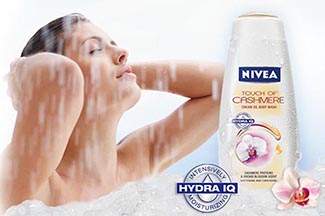
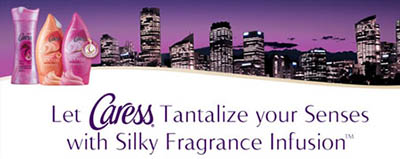
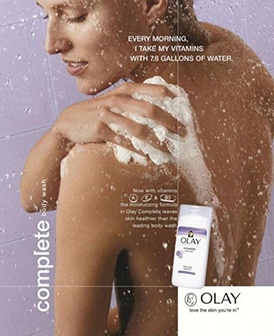

|

|
| Ads targeted at women face a much different task, given that body care is already presumed to be a gender-appropriate (if not inherently feminine) activity. Thus, the strategies these ads employ rely more on presenting the use of the product as enjoyable and pleasurable, drawing attention to a low price, and billing the product via rhetorics of health. |
| "Moisturizing" attributes are a significant selling point, with an emphasis on soft, pleasant feeling. Products are described as "Silky" and can be used to "Tantalize your Senses". One ad makes a chemistry pun by saying its product "turns H2O into H2Ohhhh!" The joke promotes the idea that the use of body wash creates pleasant enough sensations for the user to be akin to a massage, inducing a happy sigh.
Olay's ad equates their body wash with taking vitamins as a way of communicating the intensity of the moisturization claim. On a related note, the link between body wash and health is extended by cultivating an association between these products and fruit, especially citrus and red fruits. No doubt men's body wash also is fruit-scented to some degree, but it's in these ads that any actual fruit is shown pictured. Flowers, while not featured prominently, appear as a motif in almost every ad in the sample. Sometimes, as with the fruit, flowers represent the fragrance of the product in a more-or-less literal fashion (cherry blossoms pictured for a "cherry blossom" fragrance), while other times, the relationship is more abstract (a rose pictured for "passionate spell", a lily of some sort for "endless kiss"). Flowers are even shown on the bottles and in the ads when no particular fragrance claim is made. |
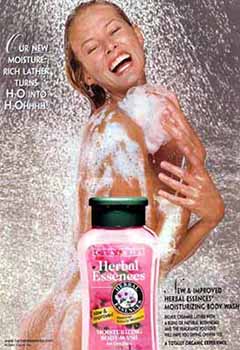
|
| Both the frequent use of flowers and the claims of "moisturizing" (softening) effects fit within and perpetuate an understanding of womanhood that is inextricably tied with fragility, softness, and delicateness. In outdoor recreation advertisements, for example, women "are shown as not primarily interested in wilderness recreation. Instead, they are appealed to by promoting shopping, spas, and yoga retreats, suggesting that women do not want, or are even incapable of, 'roughing it' in the wilderness" (McNiel 51). |
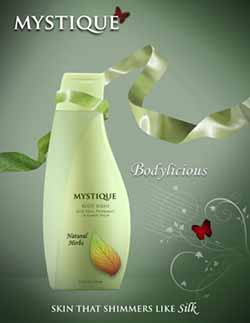
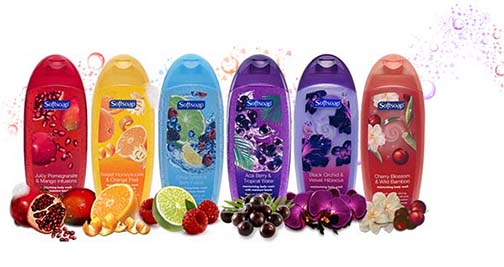

| Combined with the tactile appeals of moisture, softness, and silkiness, another motif is that of food and the sense of taste. Products are shown with images of fruit and marketed on the basis of their similarity to fruit. What's more, effect of body wash is compared to one of taste: the products will make you "bodylicious" and give you "deliciously smooth skin". Why anyone would want to make themselves tasty is never specified, except with the implication that being "delicious" (pleasant to be consumed) is simply a part of female beauty norms. |
|
Responding to the use of the product, the human figures are often shown with eyes closed, as if in bliss. One's open-mouthed facial expression could be read as a grimace in other contexts, but in this one, with the text to anchor it, the preferred reading appears to be one of overwhelming joy. |
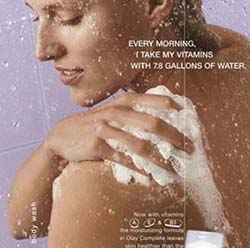
|
When the collarbone is not covered in some other way (a border of bubbles as the image cuts off, for example), feminine-coded figures consistently pose with their arms folded inward, covering their chests. This is presumably done as a matter of adherence to legal restrictions, but as noted, there is more than one way around this issue. The choice to pose figures with inward-folded arms, while inhibiting erotic readings to some degree, also serves to give the figures a more internalized, self-conscious effect, as arms-over-chest is classic defensive/protective body language and is a far cry from more confident or assertive posture. |
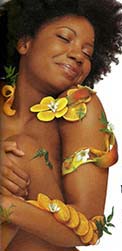 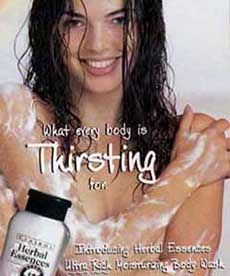
|
|
In sociologist Erving Goffman's analysis of gender in advertising -- conducted with a sample of over five hundred images -- he concluded that, "Women more than men, it seems, are pictured engaged in involvements which remove them psychologically from the social situation at large, leaving them unoriented in it and to it, and presumably, therefore, dependent on the protectiveness and goodwill of others" (Goffman 57). This phenomena is something he termed "licensed withdrawal", and in effect, it makes figures look physically vulnerable -- a trait expected of women and considered inappropriate in men.
In addition to vulnerability, poses of licensed withdrawal also suggest high emotion: "in ads women, more than men, appear to withdraw themselves... through involvements, including emotional response. Significant here are the responses of pleasure, delight, laughter, and glee -- states of being transported by happiness... some sort of final satisfaction in goals that can be fully realized in the present" (Goffman 68). In women's ads, feminine-coded figures are posed to look extremely happy, particularly in relation to the way the product, itself, feels (an impression sometimes augmented by the text). |
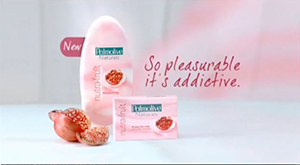
|
For women, then, the use of body wash is being billed as an inherently pleasurable experience, in and of itself ("so pleasurable, it's addictive"), rather than simply a means to an end.
Also, even in this small sample with few human figures, there is an ad that shows a figure's lower back and an ad that shows a figure's thigh. None of the figures are posed wearing towels wrapped around themselves. |





|
Like the thin feminine-coded figures with only light, if any, musculature, the fontfaces of these ads regularly feature instances of thin, curvy, italicized, swirling, and even cursive design. Associated with femininity, both the ideas of thinness and curves reflect societally-imposed female body ideals. Lest we assume that the encouragement of such normalizing forces wasn't intentional here, one ad even outright states (or commands), "Declare your beauty". |

|
|
In that vein, body wash is being promoted as a means to an end as well as an experience: a means toward beauty, and (more overtly in the Olay ad) a means toward healthy skin, which is itself highly associated with good looks. Through its assertions about what the products can do for women, the discourse of women's hygiene is already making a presumption (and therefore, a claim) that these are the things which women want. "Beliefs about what it means to be... a woman... remain unquestioned because they are presented as unquestionable, as natural and, by implication, normal. In taking on the form of common sense, these re-presentations not only impede social change and progress, but presuppose that such change is unnecessary" (Budgeon 63). What the discourse of these ads claims is that women need to be beautiful and that the use of silky-soft body wash will grant them extreme pleasure in making themselves soft and pleasurable to the taste. |
|
Budgeon, Shelley. "Fashion Magazine Advertising". Gender & Utopia in Advertising: A Critical Reader. Lisle, IL: Procopian Press: 1994. Print. Caress Ad 1. N.d. Graphic. Hey! It's Free!. Web. 29 April 2014. (http://hif.heyitsfreellc.netdna-cdn.com/wp-content/uploads/2010/04/free-caress-body-wash.jpg). Caress Ad 2. N.d. Graphic. All Things I Love. Web. 29 April 2014. (http://www.allthosethingsilove.com/wp-content/uploads/2012/12/Fullscreen-capture-1212012-12057-AM.bmp.jpg). Dial Ad. N.d. Graphic. Never Stop Learning. Web. 29 April 2014. (http://stephsantoro.blogspot.com/2008/10/media-analysis-two.html). Goffman, Erving. Gender Advertisements. Cambridge, Mass: Harvard University Press, 1979. Print. Herbal Essences Ad 1. N.d. Graphic. LTCC. Web. 29 April 2014. (http://www.ltcconline.net/lukas/gender/nympho/pics/nympho4.jpg). Herbal Essences Ad 2. N.d. Graphic. Media Studies. Web. 29 April 2014. (http://dalmasetto.com/images/represent/nympho.jpg). Lux Ad. N.d. Graphic. IAD. Web. 29 April 2014. (http://ads-indian.blogspot.com/2013/07/lux-body-wash-and-facial-services-lakme.html). Mystique Ad. N.d. Graphic. Exquisite Art Design. Web. 29 April 2014. (http://exquisiteartdesign.com/img/Portfolio/Bodylicious.png). Nivea Ad. N.d. Graphic. Mommy Savers. Web. 29 April 2014. (http://www.mommysavers.com/wp-content/uploads/2011/07/nivea.jpg). Olay Ad. N.d. Graphic. Coloribus. Web. 29 April 2014. (http://files.coloribus.com/files/adsarchive/part_504/5047705/file/oil-of-olay-body-wash-shower-small-37741.jpg). Palmolive Ad. N.d. Graphic. Musings of a Marketer. Web. 29 April 2014. (http://www.nastaev.com/wp-content/uploads/2010/12/Palmolive-01.jpg). Suave Ad. N.d. Graphic. Huffington Post. Web. 29 April 2014. (http://i.huffpost.com/gen/204583/SUAVE-AD.jpg).
|